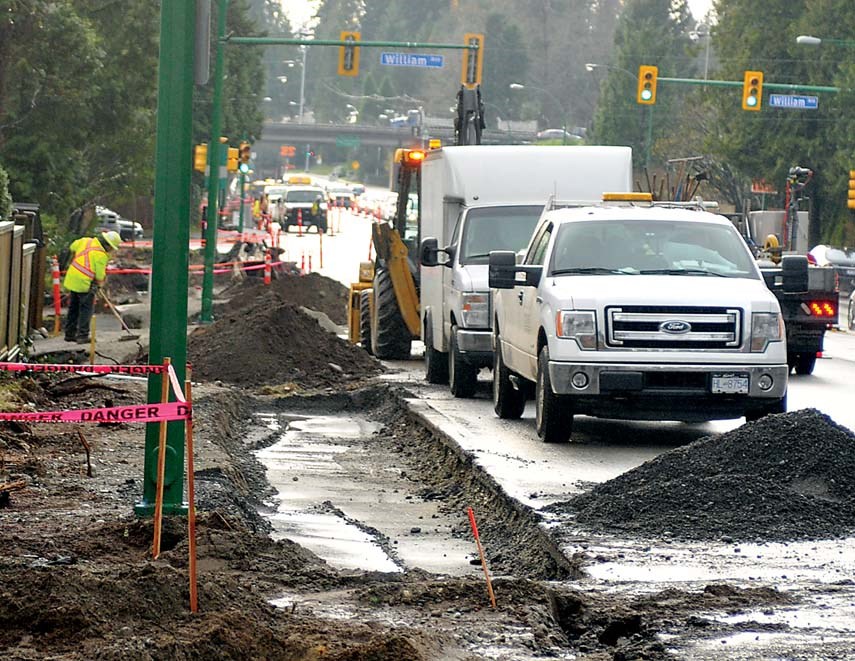Bike lanes are coming. Here are some reasons to support them.
As a Lynn Valley resident, I’ve been seeing some concern in the community at the temporary loss of the left turn lanes and established trees on Lynn Valley Road. I wanted to share some thoughts on why the bike lane project is a good thing and should be supported by the community.
Previous planning ideals aren’t working: Traffic is a hot topic in the district, but we’ve spent a century planning around the car, and while it was successful for a while, it’s now become too popular for its own good. Building wider roads is unsustainable in the long term. To add significant vehicle capacity to Lynn Valley, we would have to start removing rows of homes along our main streets to create width for more vehicle lanes. This would make travel by car easy – for a while. But the roads would soon fill up and become congested again and somewhere down the line we would have to solve the congestion problem all over again. Every time we make our streets better for cars, we make them less pleasant places for everyone else.
Cycling is one good alternative: To manage transportation demand we must shift the balance to other modes, and protected bike lanes are one of the best ways to do that. To be successful they must be built to a high standard and provide connectivity to become a viable option. Not everyone has to give up their car and ride a bike, but there is untapped demand out there. Studies have shown bike lanes actually have much higher capacity than vehicle lanes. Bicycles can travel much closer together, making much more efficient use of space. A car, usually with one person inside, takes up several metres, and on a 50 kilometres per hour road, approximately 30 metres of headway between the vehicle in front and behind. It takes up maybe 20 times more space per person than a bicycle.
Protected bike lanes work: Protected bike lanes have been proven in almost every installation to increase the number of people cycling, regardless of climate or topography. The protected bike lanes will make what is currently an unsafe arterial roadway safe enough for eight-year-old children and 80-year-old grandparents. Currently, only the brave and confident cyclists use Lynn Valley Road, that’s why you don’t see many. When the project is complete, we will see those interested in cycling but concerned for their safety start to try it out. For cyclists, it will be a delight to no longer be squeezed by fast moving vehicles buzzing their elbows. The additional space afforded by the new lanes adds comfort for drivers too as they no longer have to avoid cyclists. The protection afforded by the delineator posts while minimal adds a further degree of comfort. Undoubtedly, some of the posts will be hit by vehicles, but rather those posts than a person riding their bike, they are more easily replaced.
Cyclists pay tax too: To the claims that this project is a waste of taxpayer money and cyclists should be insured, cyclists pay taxes too. They pay property taxes, many also drive and pay gas taxes, they pay tax on things they buy, they pay tax on their income, they contribute less emissions and reduce the need for road maintenance.
To the claims for cyclists to be insured, car insurance is only required because drivers are so good at damaging things and injuring or killing other people with their cars. How many people were killed or injured by cyclists last year? Insurance would deter people from participating in a healthy activity, which provides great individual benefits as well as overall benefits to society where it becomes commonplace.
This is just the start: For cycling to become commonplace, it requires a network of safe, protected facilities. This short three-block section is just one piece of the puzzle, and the full benefits and true demand for cycling will only be realized once the network on either side is complete and provides safe meaningful continuous connections. Thankfully the district is now looking into a district-wide protected bike network. This project is a great start to that!
Roy Symons is a professional engineer and transportation planner who blogs about transportation issues at transportation-planning.com. He has no connection to the project other than living nearby.
What are your thoughts? Send us a letter via email by clicking here or post a comment below.



